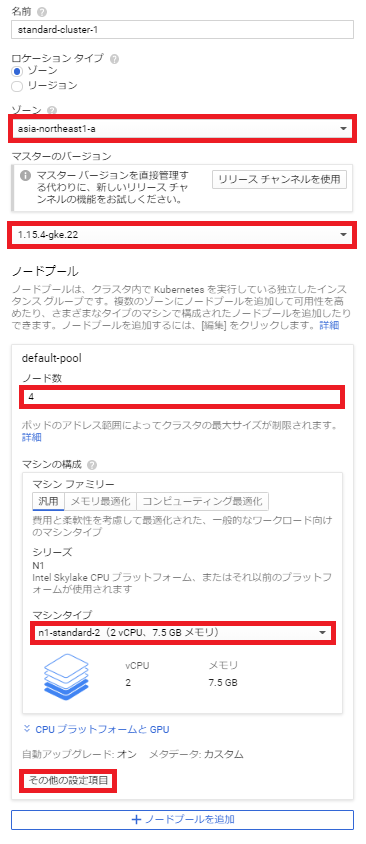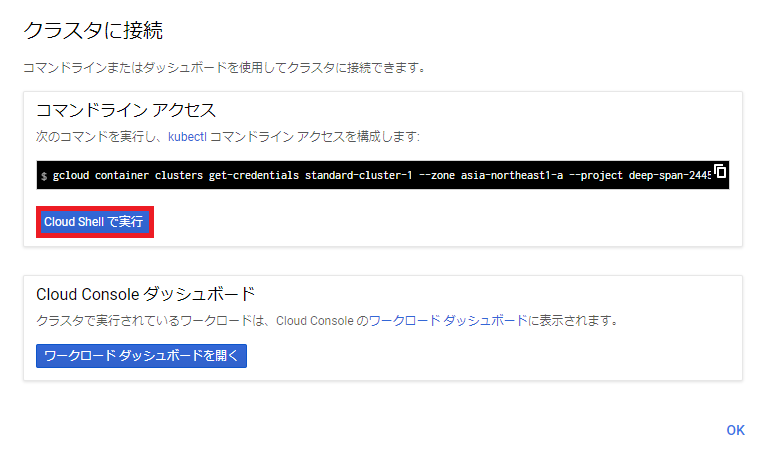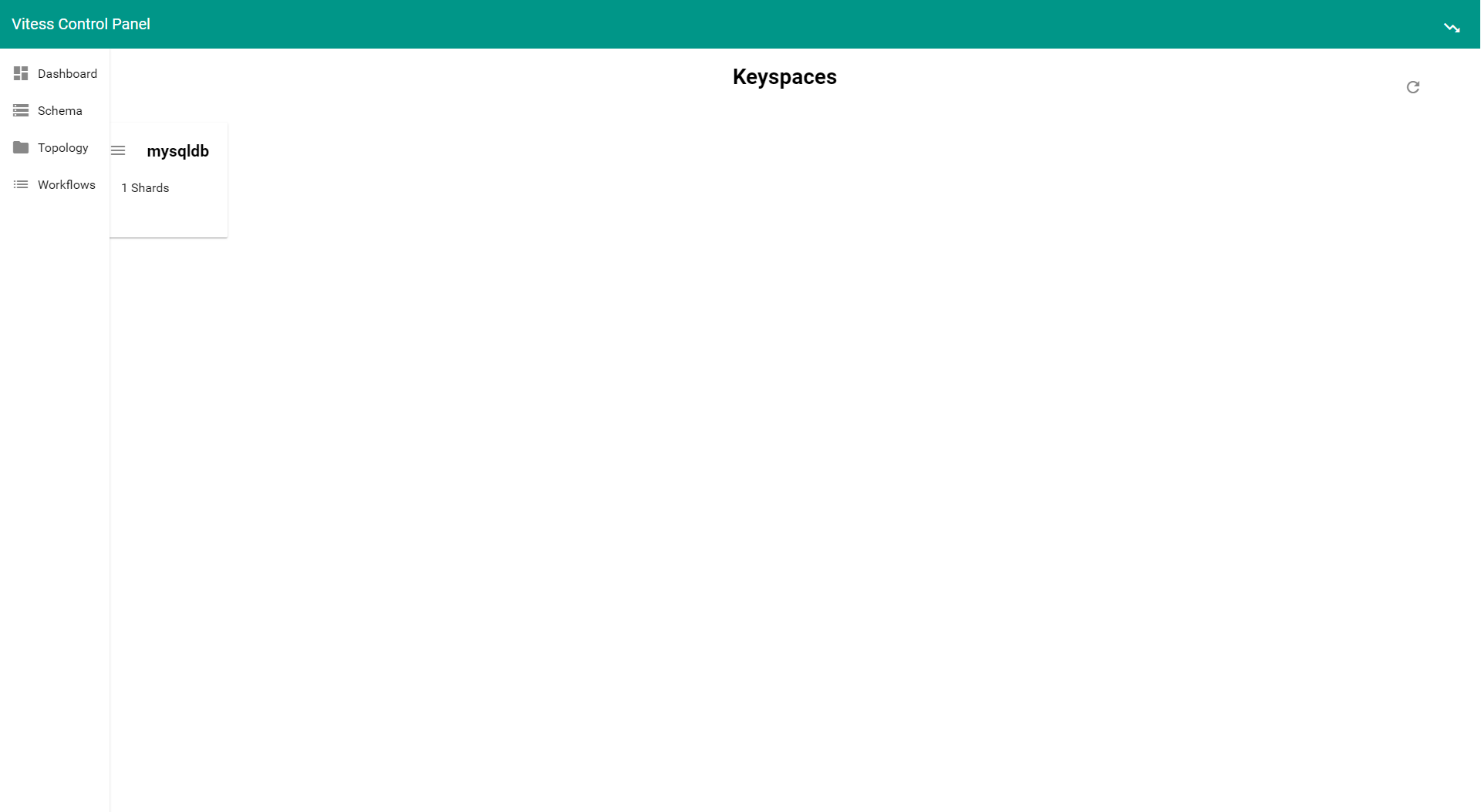2019年11月にCNCF(Cloud Native Computing Foundation)のプロジェクトとして8番目にGraduationしたVitessを試していきたいと思います。まずは環境構築から。
Vitessについては、KubeCon CloudNativeCon NA 2018,2019でRecapした資料がありますのでご参照いただければ幸いです。
- KubeCon CloudNativeCon 2018 Seattle Recap 〜Vitess〜
- KubeCon CloudNativeCon 2019 SanDiego Recap 〜Vitess〜
Vitess公式サイトのチュートリアルはminikubeをベースとしているので、GKE上に構築してみたいと思います。
1.事前準備
操作は、Cloud Shellを利用します。事前にkubernetesクラスタ、kubectl、go、helmが必要となります。Cloud Shellには、helm以外はインストールされているのでhelmをインストールします。
a.kubernetesクラスタ構築
GCPダッシュボードからKubernetesクラスタを構築します。その際のプロビジョニング内容としては以下となります。
「その他の設定項目」ボタンをクリック後、ノードで「Ubuntu」を選択します。そして、「保存」ボタンをクリックします。
最後に「作成」ボタンをクリックします。
クラスタ構築完了後、「接続」ボタンをクリックしてCloud Shellを起動します。
「Cloud Shellで実行」ボタンをクリック
Enterキーを押します。
Welcome to Cloud Shell! Type "help" to get started.
iyutaka2019@cloudshell:~$ gcloud container clusters get-credentials standard-cluster-1 --zone asia-northeast1-a --project xxxxxxxxxxxxxxxxxx
Fetching cluster endpoint and auth data.
kubeconfig entry generated for standard-cluster-1.
b.helmインストール
1.インストールスクリプトのダウンロード
$ curl https://raw.githubusercontent.com/kubernetes/helm/master/scripts/get > get_helm.sh
% Total % Received % Xferd Average Speed Time Time Time Current
Dload Upload Total Spent Left Speed
100 7164 100 7164 0 0 18587 0 --:--:-- --:--:-- --:--:-- 18559
2.スクリプトファイルに権限の付与
$ chmod 700 get_helm.sh
3.スクリプトの実行
$ ./get_helm.sh
Downloading https://get.helm.sh/helm-v2.16.1-linux-amd64.tar.gz
Preparing to install helm and tiller into /usr/local/bin
helm installed into /usr/local/bin/helm
tiller installed into /usr/local/bin/tiller
Run 'helm init' to configure helm.
4.「rbac.yml」の作成
$ vim rbac.yml
----------------------------------------------------
apiVersion: v1
kind: ServiceAccount
metadata:
name: tiller
namespace: kube-system
---
kind: ClusterRoleBinding
apiVersion: rbac.authorization.k8s.io/v1beta1
metadata:
name: tiller-clusterrolebinding
subjects:
- kind: ServiceAccount
name: tiller
namespace: kube-system
roleRef:
kind: ClusterRole
name: cluster-admin
apiGroup: ""
----------------------------------------------------
Esc + :wq
5.「rbac.yml」の適用
$ kubectl create -f rbac.yml
serviceaccount/tiller created
clusterrolebinding.rbac.authorization.k8s.io/tiller-clusterrolebinding created
6.初期化処理
$ helm init --service-account tiller --upgrade
Creating /home/iyutaka2019/.helm
Creating /home/iyutaka2019/.helm/repository
Creating /home/iyutaka2019/.helm/repository/cache
Creating /home/iyutaka2019/.helm/repository/local
Creating /home/iyutaka2019/.helm/plugins
Creating /home/iyutaka2019/.helm/starters
Creating /home/iyutaka2019/.helm/cache/archive
Creating /home/iyutaka2019/.helm/repository/repositories.yaml
Adding stable repo with URL: https://kubernetes-charts.storage.googleapis.com
Adding local repo with URL: http://127.0.0.1:8879/charts
$HELM_HOME has been configured at /home/iyutaka2019/.helm.
Tiller (the Helm server-side component) has been installed into your Kubernetes Cluster.
Please note: by default, Tiller is deployed with an insecure 'allow unauthenticated users' policy.
To prevent this, run `helm init` with the --tiller-tls-verify flag.
For more information on securing your installation see: https://docs.helm.sh/using_helm/#securing-your-helm-installation
7.helmコマンドの実行
$ helm version
Client: &version.Version{SemVer:"v2.16.1", GitCommit:"bbdfe5e7803a12bbdf97e94cd847859890cf4050", GitTreeState:"clean"}
Server: &version.Version{SemVer:"v2.16.1", GitCommit:"bbdfe5e7803a12bbdf97e94cd847859890cf4050", GitTreeState:"clean"}
2.Vitessクラスタ構築
a.vtctlclientのダウンロード
gopathは、ホームディレクトリのgopathディレクトリとなります。
$ go get vitess.io/vitess/go/cmd/vtctlclient
$ echo $GOPATH
/home/iyutaka2019/gopath:/google/gopath
b.etcd-operatorのインストール
etcd-operatorが必要となりますので、Helmを利用してインストールします。
$ helm install stable/etcd-operator --name etcd-operator
NAME: etcd-operator
LAST DEPLOYED: Sun Dec 15 16:22:02 2019
NAMESPACE: default
STATUS: DEPLOYED
RESOURCES:
==> v1/ClusterRole
NAME AGE
etcd-operator-etcd-operator-etcd-operator 1s
==> v1/ClusterRoleBinding
NAME AGE
etcd-operator-etcd-operator-etcd-operator 1s
==> v1/Deployment
NAME AGE
etcd-operator-etcd-operator-etcd-backup-operator 1s
etcd-operator-etcd-operator-etcd-operator 1s
etcd-operator-etcd-operator-etcd-restore-operator 1s
==> v1/Pod(related)
NAME AGE
etcd-operator-etcd-operator-etcd-backup-operator-66f459f68gxk9k 0s
etcd-operator-etcd-operator-etcd-operator-9f59bcb44-4f65g 0s
etcd-operator-etcd-operator-etcd-restore-operator-5f78c8d422svp 0s
==> v1/Service
NAME AGE
etcd-restore-operator 1s
==> v1/ServiceAccount
NAME AGE
etcd-operator-etcd-operator-etcd-operator 1s
NOTES:
1. etcd-operator deployed.
If you would like to deploy an etcd-cluster set 'customResources.createEtcdClusterCRD' to true in values.yaml
Check the etcd-operator logs
export POD=$(kubectl get pods -l app=etcd-operator-etcd-operator-etcd-operator --namespace default --output name)
kubectl logs $POD --namespace=default
状況を確認します。
$ kubectl get pod
NAME READY STATUS RESTARTS AGE
etcd-operator-etcd-operator-etcd-backup-operator-66f459f68gxk9k 1/1 Running 0 81s
etcd-operator-etcd-operator-etcd-operator-9f59bcb44-4f65g 1/1 Running 0 81s
etcd-operator-etcd-operator-etcd-restore-operator-5f78c8d422svp 1/1 Running 0 81s
c.オリジナルの「values.yaml」を作成
Vitessクラスタを作成する際に、どういうクラスタにするかを定義する「values.yaml」が必要となります。
雛形は、「/home/iyutaka2019/gopath/src/vitess/vitess.io/helm/vitess」にあります。
今回は必要最低限のオリジナルのマニフェストファイルを作成します。
雛形をベースに理想とするクラスタ定義を作成できます。
$ cd /home/iyutaka2019/gopath/src/vitess/vitess.io/helm/vitess
$ vim original-values.yaml
--------------------------------------------------------------
topology:
cells:
- name: "zone1"
etcd:
replicas: 3
vtctld:
replicas: 1
vtgate:
replicas: 3
mysqlProtocol:
enabled: true
authType: "none"
keyspaces:
- name: "mysqldb"
shards:
- name: "0"
tablets:
- type: "replica"
vttablet:
replicas: 2
etcd:
replicas: 1
resources:
vtctld:
serviceType: "NodePort"
resources:
vtgate:
serviceType: "NodePort"
resources:
vttablet:
mysqlSize: "prod"
resources:
mysqlResources:
vtworker:
resources:
pmm:
enabled: false
orchestrator:
enabled: false
--------------------------------------------------------------
Esc + :wq
Helmを利用してインストールします。
$ helm install . -f original-values.yaml
NAME: sweet-garfish
LAST DEPLOYED: Sun Dec 15 16:34:48 2019
NAMESPACE: default
STATUS: DEPLOYED
RESOURCES:
==> v1/ConfigMap
NAME AGE
vitess-cm 1s
==> v1/Job
NAME AGE
zone1-mysqldb-0-init-shard-master 1s
==> v1/Pod(related)
NAME AGE
vtctld-8547867c9c-vngjj 1s
vtgate-zone1-5999cbcd49-66x7z 1s
vtgate-zone1-5999cbcd49-jkz4n 1s
vtgate-zone1-5999cbcd49-mk2hp 1s
zone1-mysqldb-0-init-shard-master-fckb6 1s
zone1-mysqldb-0-replica-0 1s
zone1-mysqldb-0-replica-1 0s
==> v1/Service
NAME AGE
vtctld 1s
vtgate-zone1 1s
vttablet 1s
==> v1beta1/Deployment
NAME AGE
vtctld 1s
vtgate-zone1 1s
==> v1beta1/PodDisruptionBudget
NAME AGE
vtgate-zone1 1s
zone1-mysqldb-0-replica 1s
==> v1beta1/StatefulSet
NAME AGE
zone1-mysqldb-0-replica 1s
==> v1beta2/EtcdCluster
NAME AGE
etcd-global 1s
etcd-zone1 1s
NOTES:
Release name: sweet-garfish
To access administrative web pages, start a proxy with:
kubectl proxy --port=8001
Then use the following URLs:
vtctld: http://localhost:8001/api/v1/namespaces/default/services/vtctld:web/proxy/app/
vtgate: http://localhost:8001/api/v1/namespaces/default/services/vtgate-zone1:web/proxy/
状況を確認します。
$ kubectl get pod,job
NAME READY STATUS RESTARTS AGE
pod/etcd-global-zg454xvc4v 1/1 Running 0 2m9s
pod/etcd-operator-etcd-operator-etcd-backup-operator-66f459f68gxk9k 1/1 Running 0 14m
pod/etcd-operator-etcd-operator-etcd-operator-9f59bcb44-4f65g 1/1 Running 0 14m
pod/etcd-operator-etcd-operator-etcd-restore-operator-5f78c8d422svp 1/1 Running 0 14m
pod/etcd-zone1-9fs8jzsvs7 1/1 Running 0 88s
pod/etcd-zone1-tdkkpt5cdk 1/1 Running 0 2m9s
pod/etcd-zone1-zcm8h9h8x6 1/1 Running 0 112s
pod/vtctld-8547867c9c-vngjj 1/1 Running 1 2m9s
pod/vtgate-zone1-5999cbcd49-66x7z 1/1 Running 2 2m9s
pod/vtgate-zone1-5999cbcd49-jkz4n 1/1 Running 3 2m9s
pod/vtgate-zone1-5999cbcd49-mk2hp 1/1 Running 2 2m9s
pod/zone1-mysqldb-0-init-shard-master-fckb6 0/1 Completed 0 2m9s
pod/zone1-mysqldb-0-replica-0 6/6 Running 0 2m9s
pod/zone1-mysqldb-0-replica-1 6/6 Running 0 2m8s
NAME COMPLETIONS DURATION AGE
job.batch/zone1-mysqldb-0-init-shard-master 1/1 68s 2m10s
d.Vitessダッシュボード
Vitessにはブラウザで利用できるvtctldダッシュボードがあります。Serviceを確認してみるとvtctldがNodePortでポートが32132となっているので、4ノードのどれか一つの「EXTERNAL-IP:32132」にブラウザでアクセスしてみます。
EXTERNAL-IPは、GCPダッシュボードから左メニュー「Compute Engine」-「VMインスタンス」で表示される4ノードの外部IPリスト確認できます。
※NodePortはランダム生成されるので構築の都度変わります。
$ kubectl get svc
NAME TYPE CLUSTER-IP EXTERNAL-IP PORT(S) AGE
etcd-global ClusterIP None <none> 2379/TCP,2380/TCP 7m12s
etcd-global-client ClusterIP 10.4.1.122 <none> 2379/TCP 7m13s
etcd-restore-operator ClusterIP 10.4.8.27 <none> 19999/TCP 19m
etcd-zone1 ClusterIP None <none> 2379/TCP,2380/TCP 7m12s
etcd-zone1-client ClusterIP 10.4.4.96 <none> 2379/TCP 7m13s
kubernetes ClusterIP 10.4.0.1 <none> 443/TCP 39m
vtctld NodePort 10.4.5.153 <none> 15000:32132/TCP,15999:31100/TCP 7m13s
vtgate-zone1 NodePort 10.4.14.125 <none> 15001:30100/TCP,15991:32685/TCP,3306:30148/TCP 7m13s
vttablet ClusterIP None <none> 15002/TCP,16002/TCP 7m13s
http://EXTERNAL-IP:vtctld NodePort Number/
e.MySQLクライアント
mysql-clientのPodを作成してデータベースを確認してみます。
MySQLのIPアドレスは、vtgate-zone1のClusterIPとなります。前項で確認した内容だと10.4.14.125です。
$ kubectl run mysql-client --image=imega/mysql-client --restart=Never -it --rm -- sh
If you don't see a command prompt, try pressing enter.
/ # mysql -h 10.4.14.125
Welcome to the MariaDB monitor. Commands end with ; or \g.
Your MySQL connection id is 1
Server version: 5.7.9-Vitess Percona Server (GPL), Release 29, Revision 11ad961
Copyright (c) 2000, 2018, Oracle, MariaDB Corporation Ab and others.
Type 'help;' or '\h' for help. Type '\c' to clear the current input statement.
MySQL [(none)]> show databases;
+-----------+
| Databases |
+-----------+
| mysqldb |
+-----------+
1 row in set (0.002 sec)
MySQL [(none)]> exit
Bye
/ # exit
pod "mysql-client" deleted
※mysql-clientのPodはexitすると「--rm」オプションによりdeleteされます。
今回は、環境構築編としてここまでとします。次回はアプリケーションと連携してみたいと思います。
あと、PlanetScale社が提供するCNDb(Vitess as a Service)を利用して簡単に構築もできる感じですね!





